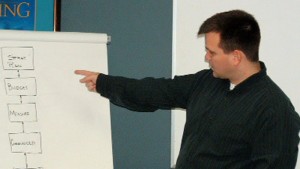To have a business offsite meeting or not have a meeting offsite? That is the question many businesses are asking.
For many business leaders in Northwest Arkansas, this is an important decision they are making once and possibly several times a year. Many business leaders are trying to get their team excited, ready for the holiday season and hopefully, turning the red on their P&L statement to black.
For others, in the back half of the year, it’s time to start planning for next year, looking at budgets, forecasting trends and deciding on the new services, products or ways to compete and grow in the coming year.
No matter your goals, deciding where and how your employees should meet to achieve them can be very important. For smaller businesses or those with lower headcount, they might have only one chance to get their team together to accomplish a goal. Pulling everyone away might mean closing your doors for a day, losing sales or adding payroll hours to days-off.
So how do you determine whether an offsite meeting is worth the cost? Well, it depends on what you need to get done, who is attending your offsite and any other extra items to you want to fit in while this team is together. Let’s start with the goals…
What’s the purpose and goal(s) of your offsite meeting?
There’s an old adage that states “where there’s a meeting, there’s probably three more needed to talk about it, plan it and recap it”. For many businesses, the need to “have a meeting about a meeting” can be a big waste of money and time. Do you have a problem or goal that requires people to do, think, act differently than they would at a normal meeting? Then maybe instead of meeting about a meeting, you need to get everyone offsite and onboard at the same time?
Meetings should have a strategic purpose with the intention of filling a specific need or benefitting the business in some way i.e. you need to set a strategy, align on a new way of working, correct a problem, etc. Once you determine your goal or the problems you are solving, the content and activities in the meeting need to help you achieve the goal.
Ask yourself, what do you need to achieve in your business?
Offsite meetings can have an instant benefit when you address immediate issues, concerns, problems that prevent sales or make processes better and more efficient. Get the right minds in a room together where the outcome is something you can quickly implement and gain results. This can help you get a quicker alignment of all your staff and a quicker return on investment.
In many corporate offsite meetings, the agenda will be broken out in two may be three categories:
- Identifying and celebrating accomplishments to date
- Fixing issues, addressing noncritical work and making things better
- Looking at the future: setting strategy, brainstorming ideas, discussing what separates your company from the others
Now that you have decided what needs to be done, who is doing all the work?
Do you have the right audience?
Offsite meetings can be extremely beneficial when the purpose of your meeting is clearly articulated and achievable in the time frame allotted. You want to assess who needs to be in the room to achieve your purpose. According to Bob Frisch and Logan Chandler, in the Harvard Review article Off-sites That Work, a mistake companies make is inviting too many people to the meeting.
Their example is an executive brings her whole team to a meeting because she is afraid of being put on the spot, not having an answer to a question or providing what the meeting needs. Is that an issue of her not understanding the purpose of the meeting or her lack of confidence in the knowledge of her team’s work? Either way, with her whole team there, it might be a distraction or a issue for the other department heads.
Frisch and Chandler say inviting too many people or too many levels down can be an issue because some voices in the room may be more important than others or some topics may be of a sensitive nature. Bringing everyone to the meeting invites comments and conversations that can derail the direction, doesn’t address the issue at the appropriate level or does not support the direction of the leaders’ strategy.
Conversely, not having the people you really need in the room or not having their full attention can cause your conversation to stall or, risk leaving your offsite without goals accomplished or a clear path forward.
In George Sell’s article On-Site vs. Off-Site Training, he interviewed several executives who reported the following:
“At times we’ve run leadership development programs in our training center,” notes Michael Molinaro, vice president and CLO at New York Life Insurance Company, “and we realize that senior leaders sometimes can be caught up in what’s going on here day to day. Being physically in the building, it can be difficult to mentally break from their work. Going away allows participants to both physically and mentally separate from the work environment and understand that they’re putting that time aside .”
Anderson echoes that concern with on-site training: “The biggest risk is being distracted because if we have people flying in from across the U.S. and we know they’re here, then there’s often the need to go and speak with them while they’re on-site, to get their input or feedback on something. So ancillary or pop-up meetings are a challenge .”
Create the right agenda, have the right people in the room, focused and removed from the distractions of everyday work. This can help ensure you get the return on investment that you need.
Depending upon your agenda and who is in the room, you may want to take advantage of other benefits by bringing your team together in an offsite meeting.
Building Camaraderie
Many businesses host picnics, holiday parties and other events to encourage their employees to build relationships outside of the office. When people get to know each other outside of immediate areas of work, it can create a heightened comfort level which builds familiarity and trust. Most people have a life outside of work (we all know a few that this may not apply to) and establishing interest in an individual outside of “what they can do for your piece of the business” can make that person feel valued. This is true at all levels, from the janitor to those in the corner suite.
Hosting a meeting offsite, in a relaxed environment creates conversations that go beyond work and helps build camaraderie. Bringing them into a place, like Simple Pleasures pictured here, brings up sharable memories, fosters conversations that offer a deeper understanding of each person and can create bonds with similar interests or experiences. When you can build this feeling into a meeting that also furthers your business objectives, that adds higher value to your meeting.
Fostering Candid Conversations
Building the camaraderie and putting people in a comfortable, fun casual environment also fosters more candid conversations amongst the attendees. Getting them out of their normal work environment and out of their self-created professional persona, can help you tap into your employees most honest selves and allow for more comfortable conversations.
Increasing Creativity
Bring your team to a place that activates the creative side of their mind might help your agenda. Having an offsite at a place like Simple Pleasures would move your team into a creative mindset. With the colorful Americana decor, interesting historical toys, cars and art – it brings up memories for some, fantasies for others but ultimately creates positive thoughts and ideas that carry into your meeting.
Simple Pleasures also has beautiful landscaping and outdoor areas of interest that allow people to roam around, get fresh air and allow businesses to have meetings in multiple areas of the campus to increase excitement, engagement and reduce the post lunch sleepiness.
Where can you take your team to help access their creative side and that can really tap into their other senses?
Shows the Leaders from Followers
Lastly, getting your team offsite can have unexpected benefits, by just putting your team in a different environment. In David Roth’s article in Forbes magazine titled Looking for Leaders…Take Your Team Off-site, he states that taking a team offsite in a different environment can allow you to see your employees in a new way. Some might feel more comfortable speaking up or participating an activity that shows critical thinking, problem-solving or other valuable skills that might not be seen in the regular work environment. This is a good way to look for potential talent to move up the ladder or, opportunities to move leaders or projects around to other areas of your company allowing hidden strengths to benefit a new area.
Your finance manager may have a degree in accounting and they are great at managing the books but, you might see their logical mind start working through the problems you are having with moving enough product out of a warehouse. Logistics is based on numbers – moving the most number of products to X amount of places using the fewest trucks, miles, boxes and other supplies. Pairing individuals in your company together with differing areas of expertise to address issues outside of their day to day management area can reveal possible assets that you did not know you had.
Recap: Is an offsite meeting right for your team and worth the cost?
Going through all of this information can be time-consuming to weigh the cost vs. the benefits of getting the team out of their comfort zone however, in many cases, the benefit of the experience for your staff in addition to the items you can achieve, is worth it
- Decide what your business goals and objectives are and if they can be achieved in a staff meeting or not
- Confirm who you need in the meeting and if you can keep them focused and actively engaged where you are
- Determine what other soft skills and strengths you need in this team or what you need to develop
- Compare the immediate expense of payroll, food and other items to what you can save or generate in sales, short term and long term
Thanks for reading.







Comments are closed.